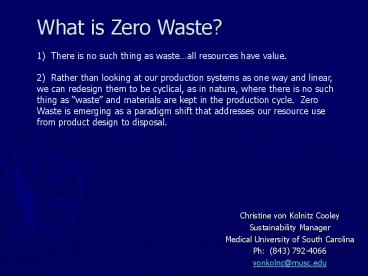Christine von Kolnitz Cooley - PowerPoint PPT Presentation
1 / 7
Title:
Christine von Kolnitz Cooley
Description:
These cities have achieved approximately 50% diversion: Seattle; San Jose; Twin Cities, MN; and smaller cities like Poway in northern ... – PowerPoint PPT presentation
Number of Views:40
Avg rating:3.0/5.0
Title: Christine von Kolnitz Cooley
1
What is Zero Waste? 1) There is no such thing
as wasteall resources have value. 2) Rather
than looking at our production systems as one way
and linear, we can redesign them to be cyclical,
as in nature, where there is no such thing as
waste and materials are kept in the production
cycle. Zero Waste is emerging as a paradigm
shift that addresses our resource use from
product design to disposal.
- Christine von Kolnitz Cooley
- Sustainability Manager
- Medical University of South Carolina
- Ph (843) 792-4066
- vonkolnc_at_musc.edu
2
Encouraging Zero Waste
- There are four central concepts to the Zero Waste
system - Change the rules to support resource recovery
- Producer responsibility to hold industry liable
for creating less toxic and more efficient
products - Purchasing for Zero Waste to use our buying power
as our voice for Zero Waste - Resource recovery infrastructure to build the
processing and recovery systems to move us toward
Zero waste
3
Encouraging Zero Waste
- Change the rules to support resource recovery
- Identify current local and state laws
- Waste composition study
- City Council and Mayoral support
- Zero waste resolution (Boulder, Oakland, Palo
Alto, etc) - Ordinance to ban certain items from disposal in a
landfill - All toxic products, yardwaste (work toward no
ADC), c d, cardboard, batteries, electronics - Ordinance to prohibit sale of unnecessarily toxic
or polluting products ex. plastic bags (San
Francisco, etc) - Shift subsidies, example use Pay As You Throw
system - Policies that make it easy to recover materials
instead of waste them - Hold zero waste meetings and events
- Hire a program coordinator
- Educate
4
Encouraging Zero Waste
- Producer responsibility to hold industry liable
for creating less toxic and more efficient
products - Design for the environment
- All products should be non-toxic, durable,
repairable, reusable, recyclable or compostable - Incentives for clean production and distribution
methods - Distribution and retail centers work with
manufacturers to reduce packaging and reuse items
such as pallets and crates - Retail centers educate consumers on proper
disposal methods
5
Encouraging Zero Waste
- Purchasing for Zero Waste to use our buying power
as our voice for Zero Waste - Consumer demands non-toxic, durable, reusable,
recyclable, and compostable products - Ordinance to buy recycled content products
6
Encouraging Zero Waste
- Resource recovery infrastructure to build the
processing and recovery systems to move us toward
Zero waste - Extended producer responsibility
- Producer has the legal, financial and
environmental responsibility for materials
entering the waste stream - Voluntary examples Dell, RBRC
- Invest in recovery infrastructure, not landfills
- No more tax funds for landfills or incinerators
- Use tax funds to build Resource Recovery Parks
- Example CHARM Boulder
- Maximize Employment Opportunities
- Sorting and processing recyclables alone sustains
ten times more jobs than landfilling or
incineration. Wasting and Recycling in the
United States 2000
7
Is Zero Waste Attainable?
- These cities have achieved approximately 50
diversion Seattle San Jose Twin Cities, MN
and smaller cities like Poway in northern San
Diego County and Takoma Park, MD. - The State of New Jersey has reported a 56
statewide diversion rate and the Australian
Capital Territory of Canberra has adopted a Zero
Waste goal by 2010. - Halifax, Nova Scotia has adopted a resource
management strategy to achieve Zero Waste. - 97 diversion - Mad River Brewing in Northern
California - 95 diversion - Zanker Construction Demolition
Landfill in San Jose, CA - 97 diversion - Hewlett-Packard in Roseville, CA
- 95 recycling rates at office buildings in the
EPA Green Buildings program - 80-90 diversion rates at many businesses
- Some progressive businesses are now adopting
Factor 10 goals to achieve a ten-fold increase in
efficiency































